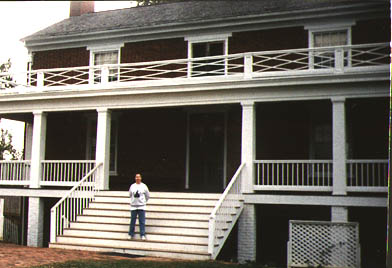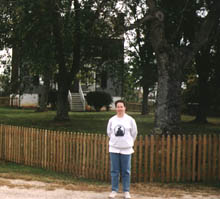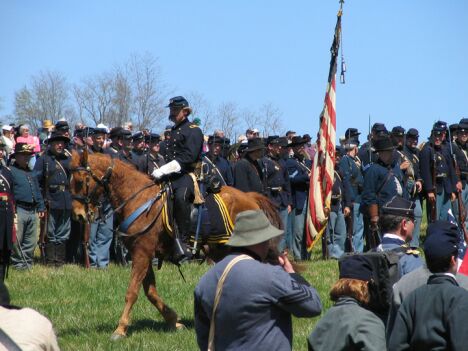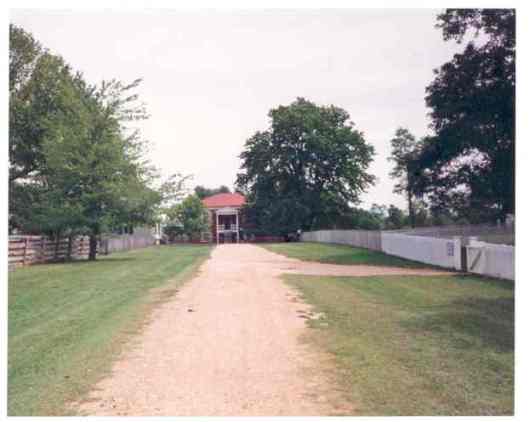TO THE LIMITS OF THE SOUL'S
IDEAL:
APPOMATTOX

Me, standing in front of the
Wilmer McLean house, site of the Confederate surrender, April 9,
1865, Appomattox Court House National Historical Park, VA.
Photo taken by
Cheryl
Pula.
The day Cheryl and I visited
Appomattox Court House, there were but a handful of visitors about. I
remember going into the McLean House and looking into the parlor,
where Generals Grant and Lee met. As I looked inside, I could not
believe how small the room was! The paintings of the scene all made
it look so huge.
After an all-night march, the weary men of the Fifth Corps--along
with the Second and Sixth Corps--finally cornered what was left of
the Army of Northern Virginia, near the village of Appomattox Court
House. Sheridan's cavalry had been fighting a pitched battle with the
Confederates, and needed assistance from any available infantry.
Chamberlain was concerned he would be receiving a flank attack
himself, when suddenly he sees a sight he never expected to see:
"Suddenly rose to sight
another form, close in our own front--a soldierly young figure, a
Confederate staff officer undoubtedly. Now I see the white flag,
earnestly borne, and its possible purport sweeps before my inner
vision like a wraith of morning mist. He comes steadily on...my mood
so whimsically sensitive that I could even smile at the material of
the flag--wondering where in either army was found a towel, and one
so white. But it bore a mighty message--that simple emblem of homely
service, wafted hitherward above the dark and crimsoned streams that
never can wash themselves away."(22)
Unknown to either Chamberlain or his men, a truce had been
called.
"The messenger draws
near...delivers his message: 'Sir, I am from General Gordon. General
Lee desires a cessation of hostilities until he can hear from General
Grant as to the proposed surrender."(23)
Chamberlain is stunned by the word: "Surrender!" He thinks of how
many times it was so close, yet snatched away--how often dreamed of,
but never realized. He comes to his senses long enough to reply:
"'Surrender?' It takes a
moment to gather one's speech. 'Sir', I answer, 'that matter exceeds
my authority. I will send to my superior. General Lee is right. He
can do no more'...I bid him wait a while, and the message goes up to
my Corps commander, General Griffin, leaving me mazed at the boding
change."(24)
Yes, the flag of truce had come in, but just then a loud
cannon-shot from the direction of Appomattox crashes into the Union
line, killing Lt. Hiram Clark of the 185th New York--a young officer
in Chamberlain's brigade, whom he admired very much. Clark became one
of the last men killed in the Army of the Potomac.
As news of the surrender spreads, however, the Union troops go
absolutely nuts--loud cheers erupt, men jump up and down, caps
and knapsacks fly upward. Finally, after four long years, the war is
over.

Me, standing in front of the
"Peers House", near the "Surrender Triangle", Appomattox Court House
National Historical Park, VA.
Photo taken by
Cheryl
Pula.
Cheryl and I strolled through
this reconstructed village, peeking into various buildings. But when
we got to this corner, I wanted to burst into tears. I had seen a
painting by artist Don Troiani in the old courthouse, which depicted
the surrender ceremony--and which showed Chamberlain and his men
positioned near where I now stood. I was seized by the thought: "He
was here! He was here!" "He", meaning
Chamberlain.
Speaking of the "Peers House": I
have a friend who works at Appomattox Court House, named Patrick
Schroeder. He is the Park Historian there--and he also portrays
George Peers, who lived in the above house. Peers was a prominent
Appomattox citizen. And on a recent visit to Syracuse, Patrick shared
the following anecdote about Mr. Peers, and Joshua Lawrence
Chamberlain:
While Chamberlain and his men were camped in
the Appomattox area, George Peers--a citizen of Appomattox--invited
Chamberlain to dine with him. Years after the war, Mr. Peers
renimisced to a writer about that meal. He spoke very highly of
Chamberlain. And he was especially grateful to the General for
bringing REAL COFFEE, which was a wartime scarcity in the
South!
Although the surrender itself was signed April 9, 1865, General
Grant had decided that a surrender ceremony should be held, in order
to make certain to the former Rebels that, indeed, the war was over.
They were to hand over their weapons and their battle colors, but
keep their sidearms and their horses. A surprise, and a great honor,
was in store for Chamberlain:
"Late that night [April
9], I was summoned to headquarters, where General Griffin
informed me that I was to command the parade on the occasion of the
formal surrender of the arms and colors of Lee's army...Griffin added
in a significant tone that Grant wished the ceremony to be as simple
as possible, and that nothing should be done to humiliate the manhood
of the Southern soldiers."(25)
So it happened that this VOLUNTEER OFFICER, was
chosen by General Grant himself, out of all the officers (volunteer
AND Regular army) in the Army of the Potomac, to receive the "arms
and colors" of the Army of Northern Virginia. In later years, when
asked why he thought he'd been chosen for this honor, Chamberlain
would say that he figured General Griffin had something to do with
it. Upon hearing this news, Chamberlain asked the new Fifth Corps
commander one thing: he wanted to be given the First Division's Third
Brigade--which included the 20th Maine--because he had shared so many
battles with them, and wanted them beside him, in this historic hour.
Griffin agreed, and transferred Chamberlain to the Third Brigade.
The ceremony took place three days later, on April 12, 1865--four
years to the day since the first shots were fired on Fort Sumter,
South Carolina.

No--there was no color photography at
Appomattox in April 1865! This picture was taken at the 140th
anniversary reenactment at Appomattox, VA, in April 2005. The
reenactor certainly looks like Chamberlain. And I think it gives one
a great idea, of what the moments before the ceremony must have been
like.
Special thanks to my friend
Mindy
Eckler,
for sending me this photo--and to my dear friend Thomas Fleming for
reducing the size for me!
Do not use without Mrs. Eckler's
written permission.
"It was now the morning of the
12th of April. I had been ordered to have my lines formed for the
ceremony at sunrise. It was a chill gray morning, depressing to the
senses. But our hearts made warmth. We formed along the principal
street...to face the last line of battle, and receive the last
remnant of the arms and colors of that great army which ours had been
created to confront for all that death can do for life. We were
remnants also: Massachusetts, Maine, Michigan, Maryland,
Pennsylvania, New York; veterans, and replaced veterans; cut to
pieces, cut down, consolidated, divisions into brigades, regiments
into one, gathered by state origin."(26)
Chamberlain now went back to the Third Brigade:
"As for me, I was once more
with my old command...I had taken leave of my little First Brigade,
so endeared to me, and the end of the fighting had released the
Second from all orders from me. But these deserved to share with me
now as they had so faithfully done in the sterner passages of the
campaign. I got permission from General Griffin to have them also in
the parade.."(27)
The stage was now set. What would happen in the next few minutes
would cause some controversy in the North for Chamberlain, but would
endear him to the South:
"The momentous meaning of
this occasion impressed me deeply. I resolved to mark it by some
token of recognition...which could be no other than a salute of
arms....The act could be defended, if needful, by the suggestion that
such a salute was not to the cause for which the Confederacy stood,
but to its going down before the flag of the Union. My main reason,
however, was one for which I sought no authority, nor asked
forgiveness."(28)
The Confederates broke camp for the last time, and made their way
up the Richmond-Lynchburg Stage Road, to where Chamberlain and his
men waited. Leading the way was General Lee's representative: General
John B. Gordon--a volunteer officer like Chamberlain, who had also
risen through the ranks, and who was also much-wounded in battle:
"Before us, in proud
humiliation, stood the embodiment of manhood: men whom neither toils
and sufferings, nor the fact of death, nor disaster, nor hopelessness
could bend from their resolve; standing before us now, thin, worn,
famished, but erect, and with eyes looking level into ours, waking
memories that bound us together as no other bond--was not such
manhood to be welcomed back into a Union so tested and
assured?"(29)
Chamberlain continues:
"Instructions had been
given, and when the head of each division column comes opposite our
group, our bugle sounds the signal and instantly our whole line from
right to left, regiment by regiment, in succession, gives the
soldier's salutation, from the 'order arms' to the old 'carry'--the
marching salute. Gordon at the head of the column, riding with heavy
spirit and downcast face, catches the sound of shifting arms, looks
up, and taking the meaning, wheels superbly, making with himself and
his horse one uplifted figure, with profound salutation as he drops
the point of his sword to the boot toe; then facing his own command,
gives word for his successive brigades to pass us with the same
position of the manual--honor answering
honor".(30)
The ceremony continues all day long, as
Chamberlain and his men watch the remnants of this once-great army
file in, and stack their muskets, and lay their battle-flags down. He
sees remnants of storied regiments, brigades, divisions and
corps--such as Cobb's Georgia Legion, Bushrod Johnson's Division,
Gordon's Georgians, Ransom's North Carolinians, A.P. Hill's old
corps--and Longstreet's First Corps! Men whom he faced in battle from
Antietam to Five Forks. Emotions ran high on both sides, as men laid
down their worn, but much-cherished, battle flags. Chamberlain ended
up playing a part in one such instance:
"A small group, evidently
the remainder of a regiment used as some headquarters guard, came in
last and late, after their comrades had marched away. As they gave up
their flag, stained by the blood and smoke of battle, its
color-bearer burst into tears and said to the Union soldiers, 'Boys,
this is not the first time you have seen that flag; I have borne it
in the front of the battle in many a victorious field, and I had
rather die than surrender it now'...'Brave fellow', Chamberlain
replied, 'I admire your noble spirit, and only regret that I have not
the authority to bid you keep your flag and carry it home as a
precious heirloom'. Chamberlain's kind words were repeated to others,
and the story became widely known throughout the
South."(31)

This is the old courthouse
building, which today serves as the Visitor Center at Appomattox
Court House National Historical Park. It faces one side of the
"Surrender Triangle", in the center of the
village.
Appomattox Court House National
Historical Park, VA.
Photo courtesy of
David
Lepkowski.
Do not use without his express
written permission.
The solemnity and sadness of the occasion
was leavened by a rather comic scene, involving a discussion between
Chamberlain and Confederate Brigadier General Henry Wise, a former
governor of Virginia-and the man responsibile for hanging
abolitionist John Brown in 1859. Chamberlain heard a commotion down
the line, and went to investigate--and found Wise arguing with some
of his men. Chamberlain sought to help the situation, and remarked to
Wise that the good conduct of the troops on both sides boded well for
the nation's future. Wise became belligerent:
"You are mistaken, Sir, we
won't be forgiven. We hate you, and that is the whole of
it!"(32)
As Wise looked at Chamberlain, he noticed
the rips and holes in Chamberlain's coat and sleeve--"souvenirs" of
his encounter with Wise's men at the Quaker Road--and asked him where
he got them. When Chamberlain told him, Wise retorted that he was
"fighting three army corps" and "thought it prudent to retire". When
Chamberlain told him that he was up against three regiments, Wise
angrily replied that he knew what he saw, and proceeded to lecture
Chamberlain on the "legal way" to make out paroles! By this time, it
had become a bizarre comedy, and staff members on both sides could
not control their laughter. In later years, Chamberlain recalled the
incident, using a biblical pun--but not mentioning Wise by
name:
"'The wise man foreseeth the
evil and hideth himself, but the foolish pass on and are punished,'
says the old proverb. If there are no exceptions to this rule, then
this gentleman was not rightly named."(33)
Finally, it was done, the long day
over.
Many things happened in the days and weeks
between Appomattox and the army's return to Washington. While camped
outside the town of Farmville,VA, on Easter Sunday, 1865, Chamberlain
and the rest of the Fifth Corps received the shocking news of the
assassination of President Lincoln on April 14. Fearing the worst, he
closed off the camps, hoping his men would not wreak vengeance upon
the local population. A "funeral in the field" was held on April
19th--the same day as the state funeral in the capital--and was the
scene of a potentially explosive incident:
"I summoned the senior
chaplain of the division, Father Egan, and told him we looked to him
for the memorial address, cautioning him to prepare beforehand, not
so much what to say, as what not to say. For I knew his Irish warmth
and power of speech, and that he might, if not restrained, stir the
hearts of the men too much for our
control".(34)
After some solemn music by the First
Division's German band, Father Egan rose to deliver the
oration:
"The spirit of rebellion
against the country's life and honor, he said, incited its followers
to murder the innocent and just...He then portrayed the character of
Lincoln, his integrity, his rugged truth, his innocence of wrong, his
loyalty and lofty fidelity to the people. Then having raised this
figure to its highest ideal lights and most endearing attractiveness,
he pictured him stricken down by dastard hand in the very midst of
acts of mercy and words of great-hearted sympathy and love. Gathering
up the emotions of his audience with searching, imploring glance, he
reminded the soldiers of Lincoln's love for them, and theirs for him;
that brotherhood of suffering that made them one in soul with
him."(35)
As Father Egan went on, some of the men
began to pale, and instinctively started to reach for their stacked
muskets. Chamberlain, seated near the padre on the platform, knew he
had to act quickly:
"...I myself was under the
spell. Well that the commander was there, to check the flaming
orator. Men could not hear it. You could not, were I able to
reproduce the scene. Then the speaker stopped. He stood transfixed. I
seized his arm. 'Father Egan, you must not stop. Turn this excitement
to some good.' "I will', he whispers. Then lifting his arm full
height, he brought it down with a tremendous sweep, as if to gather
in the whole quivering circle before him, and went on; 'Better so.
Better to die glorious, than to live infamous. Better to be buried
beneath a nation's tears, than to walk the earth guilty of a nation's
blood. Better, thousandfold, forever better, Lincoln dead, than Davis
living.'".
(36)
Chamberlain had defused a dangerous
situation, and the funeral ended without further incident.
In the days following the funeral,
Chamberlain became something of a "military governor" in the region
between Petersburg and Dinwiddie County. During the nearly two weeks
he served in this capacity, food was distributed to civilians who
would give the "oath of allegiance" to the Union, and to those in
need. He also had to restore some semblance of order in the
countryside. During this time, a very humorous incident occurred,
brought about by the appearance of an unnamed "Belle of Dinwiddie",
who was brought in to take the oath of allegiance by Chamberlain's
youngest brother Tom, who was serving as Provost Marshal. Evidently
Tom had a crush on the young woman--and big brother Joshua was also
somewhat dazzled by her beauty!
"...It was a comical sight
when in their presentation of the case, they exchanged glances. Her
air was that of an injured party, and he the aggressor. At every soft
impeachment his color rose to the
Jacqueminot".(37)
After some verbal sparring back and forth
between Joshua and the "belle" (whom he described as "the indomitable
Portia", for her skill in debating!), she agrees to take the oath.
Chamberlain remarks:
"Our Provost Marshal, who
kept our oaths for us, told her of the requirement, asking her to
kiss the book in token. To both of these suggestions she opposed a
very firm determination. Indeed, considering the aspect of these two
respective objects, I would not have blamed her if she preferred to
reverse the directions, swear to the book and kiss the
officer."(38)
Alas, the "relationship" did not last for
Tom, and no more mention is made of the lady in question. The Fifth
Corps, and the rest of the AOP, made its way through Petersburg and
Richmond, bypassing the old battlefield at Fredericksburg. While
camped near Hanover Court House, a bizarre incident
occurred:
"At about midnight, when the
tired camp was still, the sentinel in front of my bivouac spoke
nervously, saying there was something strange going on about my horse
not far away from us. He had been hastily tethered there amidst a
little growth of scrubby pines, so near, and the place so quiet,
there seemed to be no need of a guard...I rose and went out myself;
and before I reached him my foot crushed through the breast-bones of
a body half buried by the fallen pine-cones and needles so long
undisturbed, now gone back mostly ashes to ashes. I found that the
horse, pawing the earth within the scope of his picket-rope, had
rolled out two skulls and scattered the bones of bodies he had
unearthed, and was gazing at the white skulls as if lost in doubt;
now and then snorting to call others to solve the mystery, or swaying
at his tether as if to get away
himself."(39)
Charlemagne had discovered the bodies of
some long-dead soldiers from a previous battle. These bones were
gathered up into old cracker-boxes and taken back with the army to
Washington.
NOTE:
This Web site is Copyright © 1999- 2009 Pat Finnegan.
All rights reserved.
DO NOT use any written
material, or photographs, without first contacting me in writing.
If you do not do this, be assured that legal action will be taken.
THANK
YOU!
QUESTIONS? COMMENTS?
SEND ME AN EMAIL!
 RETURN
TO HOME PAGE
RETURN
TO HOME PAGE